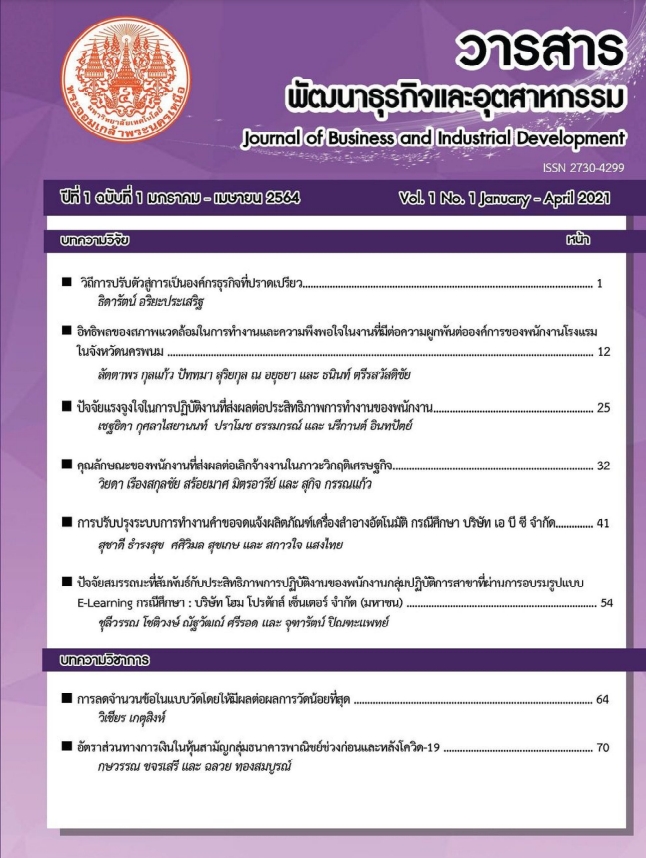วิถีการปรับตัวสู่การเป็นองค์กรธุรกิจอุตสาหกรรมที่ปราดเปรียวในยุคเศรษฐกิจผกผัน
บทคัดย่อ
บทความนี้เป็นรายงานการศึกษาวิจัยเชิงคุณภาพจากการศึกษาเอกสาร ตำราและงานวิจัยที่เกี่ยวข้อง (Documentary Review) และการสนทนากลุ่มผู้ทรงคุณวุฒิ (Focus group) มีวัตถุประสงค์เพื่อศึกษาแนวทางในการบริหารจัดการองค์กรให้มีความปราดเปรียวเกิดความคล่องตัวในการปรับตัวและปรับเปลี่ยนในยุคเศรษฐกิจพลิกผัน ในยุคที่ดิจิทัลมีอิทธิพลต่อความมั่นคงขององค์กร จากการวิเคราะห์ข้อมูลเชิงเนื้อหา (Content analysis) ผลการศึกษาพบ 3 ปัจจัยที่สำคัญซึ่งเป็นรูปแบบของการพัฒนาวิถีการปรับตัวสู่การเป็นองค์กรที่ปราดเปรียว ได้แก่ 1. ปัจจัยด้านสิ่งแวดล้อมองค์กรที่ส่งผลต่อความไม่แน่นอนและความคลุมเครือขององค์กร (Organizational Environment Toward Uncertainty And Ambiguity) ประกอบด้วย 1) ด้านสภาพแวดล้อมภายนอก (External environment) 1.1) บริบทของกลุ่มอุตสาหกรรมและธุรกิจ (Industrial and business context) 1.2) โครงสร้างทางการเงินและผู้ถือหุ้น (Financial and ownership structure) 1.3) ตำแหน่งเชิงแข่งขันในตลาด (Market competitive position) 1.4) ความแข็งแกร่งของผลิตภัณฑ์หรือตราผลิตภัณฑ์ (Brand values) และ 1.5) ประสิทธิภาพในอดีต (Past effective performance) 2) ปัจจัยด้านสิ่งแวดล้อมภายใน (Internal environment) ประกอบด้วย 2.1) วัฒนธรรมองค์กร (Organizational culture) 2.2) ทัศนคติในการบริหารความเสี่ยง (Risk management attitude) 2.3) การรับรู้สมรรถภาพของการเสริมอำนาจ (Perception of power support) และ 2.4) ภาวะผู้นำ (Leadership) 2. ปัจจัยด้านเสถียรภาพขององค์กรและความยืดหยุ่น (Sustainable and Flexibility) ได้แก่ 1) การเคลื่อนไหวปรับเปลี่ยนเร็ว (Mobility) 2) การมอบอำนาจ (Empowerment) และ 3) การตัดสินใจ (Decision making) 3. ปัจจัยด้านคุณลักษณะผู้นำการขับเคลื่อนแบบปราดเปรียว (Agile Leader Characteristics) ได้แก่ 1) การตระหนักรู้รอบ (Holistic awareness) 2) การแสวงหาข้อมูลเพื่อการตัดสินใจ (Data acquisition for decision making) และ 3) การลงมือปฏิบัติการแบบเชิงรุก (Active operation)
เอกสารอ้างอิง
Anthony, S. D. (2016, February 29). “What do you really mean by Business Transformation”. Harvard Business Review. https:// hbr.org/2016/02/what-do-you-really-mean-by-business-transformation
Diamandis, P. (2017, June 19). “Exponential Roadmap”. HuffPost News. https://.www.huffpost.com/entry/exponentialroadmaps_b_59481f16e4b0961faacbe5c3
Ramirez, V.B. (2016, November 22). “The 6 Ds of Tech Disruption: A Guide to the Digital Economy.” . Singularity Education Group. https://singularityhub.com/2016/11/22/the-6-ds-of-tech-disruption-a-guide-to-the-digital-economy/
Aghina, W. et al. (2018, January 22). “The Five Trademarks of Agile Organizations.”. McKinsey & Company. https://www.mckinsey.com/business-functions/organization/our-insights/the-five-trademarks-of-agile-organizations
Syrett, M. and M. Devine. (2012). Managing Uncertainty Strategies for Surviving and Thriving in Turbulent Times. (6th ed.). Wiley.
EYQ. (2016). “The upside of disruption Megatrends shaping 2016 and beyond.”. EYGM Limited. https://www.ey.com/Publication/vwLUAssets/EY-the-upside-of-disruption/$FILE/EY-theupside-of-disruption.pdf
Samkoset, W. (2016, November 22). “Get to know Disruptive Technologies.”. Krungthepthurakij. https://www.bangkokbiznews.com/blog/detail/639505
De Meyer, A.C.L. Loch C.H. and Pich, M.T. (2002). “Managing project uncertainty: From variation to chaos.”. MIT Sloan Management Review. 43(2). 60-67.
Courtney, H. Kirkland, J. and Viguerie, P. (1997). “Strategy Under Uncertainty”. Harvard Business Review. https://hbr.org/1997/11/strategy-under-uncertainty
Economist Intelligence Unit. (2009). “Organisational Agility.”. The Economist. https://www.emc.com/collateral/leadership/organisational-agility-230309.pdf
Woolf, A. and Tabernor, J. (2018, August 14). “Enterprise agility in financial services.” and “Exponential Roadmaps.”. Accenture. https://www.accenture.com/us-en/insights/financial-services/enterprise-agility
Press, J. & Goh, T. (2018). “Leadership, disrupted: How to Prepare Yourself to Lead in a Disruptive World.” Center for Creative Leadership. https://www.ccl.org/wp-content/uploads/2018/01/Leadership-Disrupted-White-Paper.pdf
ธิดารัตน์ อริยะประเสริฐ, สุภัททา ปิณฑะแพทย์, และธีรวุฒิ บุณยโสภณ. (2561). การพัฒนารูปแบบการจัดการองค์กรสำหรับธุรกิจอุตสาหกรรมไทยในยุคเศรษฐกิจพลิกผัน. วารสารวิชาการพระจอมเกล้าพระนครเหนือ, 30(2), 314-323
อำนวย อภิชัยนันท์. (2559). รูปแบบการพัฒนาภาวะผู้นำตามการเปลี่ยนแปลงของโลกธุรกิจเพื่อการเติบโตอย่างยั่งยืนในองค์กรวิสาหกิจขนาดกลางและขนาดย่อม (SMEs). [วิทยานิพนธ์ปริญญาดุษฎีบัณฑิต]. มหาวิทยาลัยเทคโนโลยีพระจอมเกล้า
พระนครเหนือ.
ดาวน์โหลด
เผยแพร่แล้ว
รูปแบบการอ้างอิง
ฉบับ
ประเภทบทความ
สัญญาอนุญาต
ลิขสิทธิ์ (c) 2023 วารสารพัฒนาธุรกิจและอุตสาหกรรม

อนุญาตภายใต้เงื่อนไข Creative Commons Attribution-NonCommercial-NoDerivatives 4.0 International License.





